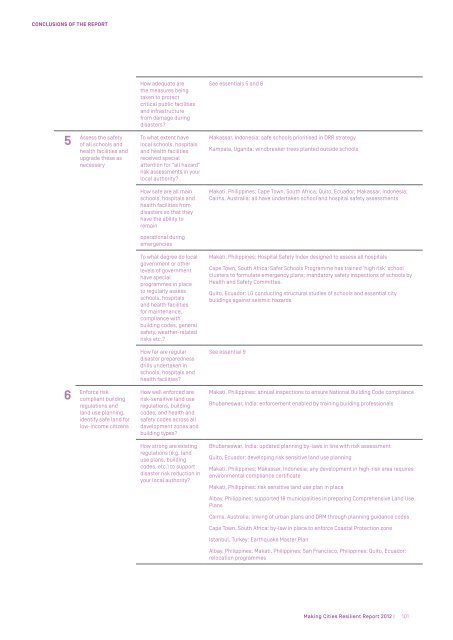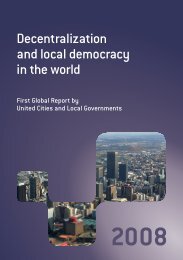Making Cities Resilient Report 2012
Making Cities Resilient Report 2012
Making Cities Resilient Report 2012
You also want an ePaper? Increase the reach of your titles
YUMPU automatically turns print PDFs into web optimized ePapers that Google loves.
CONCLUSIONS OF THE REPORT<br />
How adequate are<br />
the measures being<br />
taken to protect<br />
critical public facilities<br />
and infrastructure<br />
from damage during<br />
disasters<br />
See essentials 5 and 6<br />
5<br />
Assess the safety<br />
of all schools and<br />
health facilities and<br />
upgrade these as<br />
necessary<br />
To what extent have<br />
local schools, hospitals<br />
and health facilities<br />
received special<br />
attention for “all hazard”<br />
risk assessments in your<br />
local authority<br />
Makassar, Indonesia: safe schools prioritised in DRR strategy<br />
Kampala, Uganda: windbreaker trees planted outside schools<br />
How safe are all main<br />
schools, hospitals and<br />
health facilities from<br />
disasters so that they<br />
have the ability to<br />
remain<br />
operational during<br />
emergencies<br />
Makati, Philippines; Cape Town, South Africa; Quito, Ecuador; Makassar, Indonesia;<br />
Cairns, Australia: all have undertaken school and hospital safety assessments<br />
To what degree do local<br />
government or other<br />
levels of government<br />
have special<br />
programmes in place<br />
to regularly assess<br />
schools, hospitals<br />
and health facilities<br />
for maintenance,<br />
compliance with<br />
building codes, general<br />
safety, weather-related<br />
risks etc.<br />
Makati, Philippines: Hospital Safety Index designed to assess all hospitals<br />
Cape Town, South Africa: Safer Schools Programme has trained ‘high risk’ school<br />
clusters to formulate emergency plans; mandatory safety inspections of schools by<br />
Health and Safety Committee.<br />
Quito, Ecuador: LG conducting structural studies of schools and essential city<br />
buildings against seismic hazards<br />
How far are regular<br />
disaster preparedness<br />
drills undertaken in<br />
schools, hospitals and<br />
health facilities<br />
See essential 9<br />
6<br />
Enforce risk<br />
compliant building<br />
regulations and<br />
land use planning,<br />
identify safe land for<br />
low-income citizens<br />
How well enforced are<br />
risk-sensitive land use<br />
regulations, building<br />
codes, and health and<br />
safety codes across all<br />
development zones and<br />
building types<br />
Makati, Philippines: annual inspections to ensure National Building Code compliance<br />
Bhubaneswar, India: enforcement enabled by training building professionals<br />
How strong are existing<br />
regulations (e.g. land<br />
use plans, building<br />
codes, etc.) to support<br />
disaster risk reduction in<br />
your local authority<br />
Bhubaneswar, India: updated planning by-laws in line with risk assessment<br />
Quito, Ecuador: developing risk sensitive land use planning<br />
Makati, Philippines; Makassar, Indonesia: any development in high-risk area requires<br />
environmental compliance certificate<br />
Makati, Philippines: risk sensitive land use plan in place<br />
Albay, Philippines: supported 18 municipalities in preparing Comprehensive Land Use<br />
Plans<br />
Cairns, Australia: linking of urban plans and DRM through planning guidance codes<br />
Cape Town, South Africa: by-law in place to enforce Coastal Protection zone<br />
Istanbul, Turkey: Earthquake Master Plan<br />
Albay, Philippines; Makati, Philippines; San Francisco, Philippines; Quito, Ecuador:<br />
relocation programmes<br />
<strong>Making</strong> <strong>Cities</strong> <strong>Resilient</strong> <strong>Report</strong> <strong>2012</strong> | 101

















